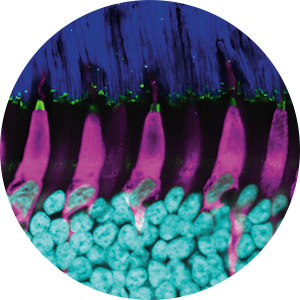A quest to save patients’ vision
Research and therapeutics
Mini-gene therapy demonstrates great promise in combating blindness among Usher 1F patients
In the race against time to save the vision of people with Usher syndrome type 1F, the Corey Lab at Harvard Medical School is sparking hope that its mini-gene strategy can reach the finish line before countless worlds go dark.

IMAGE: MARYNA IVANCHENKO
Collaborating with researchers at other institutions, scientists in the Corey Lab, including Maryna Ivanchenko, MD, PhD, an instructor in neurobiology who oversees the lab’s Usher 1F program, designed a shortened version of the gene that is mutated in Usher 1F. This rare but severe genetic disease causes deafness, lack of balance, and progressive blindness.
“It’s completely devastating to be born deaf and then lose your vision, so we hope that this mini gene can eventually be turned into a treatment for this disease,” says David Corey, PhD, the Bertarelli Professor of Translational Medical Science in the Blavatnik Institute at HMS.
The mutation renders hair cells inside the inner ear incapable of producing a key protein—protocadherin-15 (PCDH15)—involved in sound perception. In mice, the mini gene stimulated production of a shorter but still functional version of the missing protein, enabling the hair cells to sense sound and restoring hearing. Because vision loss in Usher 1F involves an only slightly different form of the same protein, the researchers say the same approach may be useful for preventing blindness.
Why a “mini gene”? PCDH15 is a huge protein, and the DNA that codes for it is too large to fit inside the usual delivery vehicle—a small capsule made from a non-infectious virus. The shortened version of the PCDH15 gene can just squeeze inside the viral capsule.
Corey’s next steps are being boosted by a $1.2 million grant from the Foundation Fighting Blindness, which was established more than 50 years ago by a passionate group of people determined to help find treatments and cures for blinding diseases affecting themselves or loved ones. Since then, the foundation has raised more than $915 million for leading-edge research in areas such as genetics, gene and stem cell therapies, retinal cell transplantation, and pharmaceutical and nutritional therapies.
In collaboration with Bence György, MD, PhD, who was once a postdoctoral fellow in Corey’s lab and is now head of clinical translation and leader of the Ophthalmic Translational Research Group at the Institute of Molecular and Clinical Ophthalmology Basel, the Corey Lab will:
- Test the mini gene’s ability to restore vision in a zebrafish model.
- Deliver the mini gene to the mouse retina, then improve the delivery method and targeting of the mini gene.
- Evaluate mini-gene delivery and targeting in human photoreceptors.
“These tests will provide baseline data to support an FDA investigational new drug application and to secure further funding,” Corey says. “This is likely the first mini-gene approach to rescue vision in any model of human hereditary blindness and will inform mini-gene strategies for other blindness genes.”